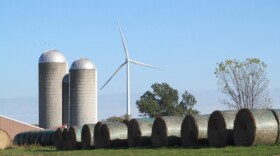A study by Stanford University professor Marc Jacobson says every state in the U.S. could get 100% of its energy from renewable sources by the year 2050 – and save money in the process.
In Michigan, most of that power would come from the state's most abundant renewable resource: wind. Forty percent of the state's electric needs could be met with on-shore wind power, according to Jacobson's analysis, and 31% from off-shore wind power.
Despite all our cloudy days, Jacobson says Michigan could get more than 26% of its electricity needs from solar energy.
"Germany has a lot of solar installed," notes Jacobson, "and the solar resources there are worse than in Michigan."
Small amounts of electricity would come from Consumers Energy's existing Ludington Pumped Storage facility and from wave devices in the lakes.
Jacobson did the state-by-state analysis for simplicity's sake. In reality, states are connected to others in shared electric grids.
He says the transmission lines in those grids would likely have to be strengthened in order for the idea to work.
And significant amounts of energy would have to be stored, since wind and solar can't be turned on in the same way as a coal-burning power plant. But he thinks plenty of power can be stored in vehicle batteries, for example, as well as soil and water. Demand for electricity could also be better controlled, with time-of-day pricing that encourages people to use less energy when there is less available.
Jacobson, a climate scientist, says the roadblocks to 100% renewables are political and social, not technical.
For example, many people living along the lakeshore are vehemently opposed to even the hint of a proposal to put wind turbines in the Great Lakes.
Jacobson says switching to renewable power would cost some jobs, but it would create many more than it would destroy.
And he says the cost of converting the nation's infrastructure would be much less than continuing to pay the high costs of burning fossil fuels, both in terms of public health consequences and the growing risks of climate change.
Jacobson's analysis shows the per-kilowatt hour cost of 100% renewables at .11 cents on average. That's about the same cost as it is now. That's primarily because the cost of electricity from a wind turbine or solar panel is in the infrastructure. The fuel – either wind or sun – is free.
Meanwhile, costs for electricity from fossil fuels keep going up.






